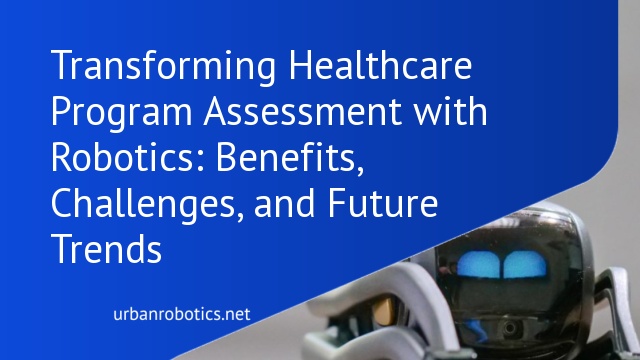Understanding Healthcare Program Assessment
Healthcare program assessment involves systematically evaluating the effectiveness, efficiency, and quality of health service programs. It’s essential for identifying gaps, improving patient care, and ensuring accountability. The assessment includes various methods such as surveys, statistical analysis, and performance metrics.
Surveys gather patient, provider, and community feedback. Data from surveys is crucial for understanding program impact and areas for improvement.
Statistical Analysis examines health outcomes and resource utilization. It provides insights into trends and correlations, helping us make data-driven decisions.
Performance Metrics measure specific outcomes like patient recovery rates, treatment adherence, and resource allocation. These metrics quantify program success and highlight areas needing attention.
By integrating robotics in these methods, we enhance data collection and analysis. Robots can automate surveys, gather real-time data, and conduct intricate statistical computations, ensuring higher accuracy and efficiency. Through this integration, the assessment process becomes more robust, paving the way for improved healthcare services.
The Role of Robotics in Healthcare
Robotics plays a crucial role in modernizing healthcare program assessment. It augments efficiency, reduces human error, and improves patient outcomes.
Enhancing Efficiency and Accuracy
Robotics boosts efficiency and accuracy in healthcare assessments by automating repetitive tasks and data collection. Robots process data faster than humans, ensuring timely analysis for better decision-making. For example, robotics streamlines survey distribution and real-time data collection, which reduces manual effort and increases precision. Automated systems also identify trends and patterns that might go unnoticed, helping in the development and improvement of healthcare programs.
Reducing Human Error
Human error, a significant issue in healthcare, is minimized with robotics. Robots execute predefined tasks consistently, eliminating common mistakes caused by fatigue or oversight. For instance, robots can manage vast amounts of data without errors, ensuring reliable and accurate information is available for program assessment. By reducing human error, robotic systems help maintain high standards and improve trust in healthcare program evaluations.
Case Studies of Robotics in Healthcare Programs
In this section, we explore real-world examples of successful robotics implementations in healthcare programs and the valuable lessons learned from these initiatives.
Successful Implementations
Several hospitals have successfully integrated robotics into their healthcare assessment programs. For instance, Cedars-Sinai Medical Center deployed AI-driven robots for post-operative patient monitoring, resulting in a 30% reduction in complications. Cleveland Clinic used robotic systems in their cardiac rehab programs, which improved patient adherence rates by 20%. Mayo Clinic leveraged robotic data collection tools to enhance their patient feedback processes, cutting survey processing time by 50%.
Lessons Learned
From these initiatives, we’ve gleaned crucial insights. Integration challenges often arise due to staff hesitation, emphasizing the need for thorough training programs. Data security remains a top priority. Adopting rigorous encryption measures ensures patient data integrity. Additionally, continuous evaluation of robotic systems helps maintain performance and adapt to changing healthcare needs, further validating the investment in these technologies.
Challenges and Limitations
Integrating robotics into healthcare program assessment brings significant benefits, yet it also presents unique challenges and limitations. We must address these to maximize the potential of robotics in this field.
Technical Challenges
Implementing robotics in healthcare poses complex technical challenges. Robots require seamless integration with existing healthcare systems, which often involves compatibility issues. Ensuring continuous operation is vital, yet many healthcare environments experience connectivity problems. Furthermore, the high initial investment in robotic technology can strain budgets, particularly for smaller institutions. Overcoming these hurdles demands substantial expertise in both IT and healthcare operations.
Ethical Considerations
Ethical considerations are paramount when adopting robotics in healthcare. Patient privacy remains a crucial concern, especially with data collected by robots. There’s also the issue of informed consent — patients must clearly understand how their data will be used. Additionally, the potential for job displacement raises concerns about the role of healthcare professionals alongside robotic systems. Balancing technological advancement with ethical responsibility ensures the healthcare industry can adopt robotics without compromising patient trust or care quality.
Future Trends
The future of healthcare program assessment with robotics promises exciting advancements. Emerging trends signify a transformative shift towards more intelligent and responsive healthcare systems.
AI Integration
Robotics in healthcare assessment is increasingly integrated with AI. This integration enhances data analysis and diagnostic precision. Machine learning algorithms empower robots to identify patterns in patient data faster than humanly possible. For example, AI-driven robots analyze medical records to predict patient outcomes and recommend personalized treatment plans. A McKinsey report states that AI could save healthcare systems up to $150 billion annually by 2026.
Policy and Regulation
Evolving policies and regulations will shape the role of robotics in healthcare assessments. Governments and regulatory bodies are likely to introduce stringent standards to ensure safety and efficacy. Compliance with data protection laws, like HIPAA in the US, will be essential for maintaining patient confidentiality. Furthermore, clear guidelines will govern the ethical deployment of robotics, addressing concerns such as bias in AI algorithms and equitable access to technology.
Conclusion
Robotics is revolutionizing healthcare program assessment by enhancing efficiency and accuracy. As AI continues to integrate with robotics, we can expect even greater advancements in data analysis and patient care. While challenges like technical issues and ethical concerns remain, the potential benefits far outweigh the drawbacks. By staying informed and compliant with evolving regulations, we can harness the full potential of robotics to improve healthcare outcomes. The future of healthcare assessment looks promising with these technological innovations leading the way.





